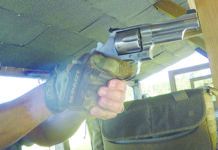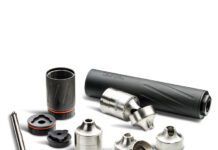When a shooter asks, “Which is the best gun for deep concealment?”, or “Is there a good self-defense gun out there with limited recoil?”, minds often turn to guns chambered for 32 Auto (32 ACP).
Many, or most, would wonder about the 32’s power, or lack of same. Gun Tests magazine addressed that concern in one part of a recent test. Beside bench-shooting for accuracy, they also created an action test that focused on what these guns would most likely be used for—that is, rapid fire at little more than contact distance.
In formulating the procedure, they took several factors into account. In close quarters there may be little or no opportunity to apply a support hand. Indeed, the hand opposite of the one holding the gun may be busy fending off a blow, the slash of a knife or, pushing back on the body of the assailant. Therefore, they decided to shoot this drill strong hand only.
The target was placed 9 feet away, and they relied primarily upon point shooting. Three strings were attempted, making note of accuracy and the elapsed time between shots (split times). The target was an IDPA-style cardboard silhouette featuring an 8-inch-diameter circle in the upper “chest” area. They aimed for the middle of the circle.
Start position was with the gun held in the right hand of the test shooter just below the point of aim with finger off the trigger. They decided that each string of fire should require that they empty a full magazine into the target. This speaks to the lower available power of 32 ACP, which in most cases produced less than 100 foot-pounds of muzzle energy.
The test gun in this and other assessments included the $361 Kel-Tec P32PK, an extremely lightweight Parkerized unit. The Kel-Tec was the small and could be carried in a pocket holster.
The gun was tested for accuracy from a sandbag rest. Test ammunition was American Eagle 71-grain TMJs, 60-grain Winchester Silvertip HP, and Speer Gold Dot 60-grain GDHP rounds. They intended to limit testing of the Kel-Tec to a distance of 7 yards. But when they saw it print sub-1-inch groups, they decided to shoot the P32PK from 15 yards as well.
Here’s what they found:
The P32PK weighed in at just 7 ounces. This is a locked-breech semiautomatic with a flush-fitting seven-round magazine. Measuring just 0.8 inches wide, the P32PK was flat enough and light enough to be carried without detection—it could even be dropped naked into a pocket. But they thought choosing one of the sheath-like holsters that protect its mechanism from lint or the trigger from loose objects such as coins was a better idea. There are even holsters, such as those from www.GrahamHolsters.com, that disguise its profile as a wallet.
The PK suffix stood for Parkerized, which is the black, glare-killing finish found on the top end. The P32PK is Kel-Tec’s medium-priced model. Fit with a blue steel slide, the P32 sells for a suggested retail price of $318. Topped with a stainless steel slide, the price was $377. All three guns are the same size, not quite big enough to fill the open hand of an average-sized man. With the magazine in place, the base pad completed the front of the grip, measuring only about 1.3 inches from the bottom of the trigger guard. This meant gripping the P32 only required the middle and ring fingers. The sides of the narrow 0.7-inch grip were covered with checkering cleanly molded into the polymer. The 1.8-inch-long backstrap featured vertical lines and a brief palm swell. The magazine release was found at the lower rear corner of the trigger guard on the left side. It operated in the traditional pushbutton manner. Inside the body of the grip was an aluminum sub-frame containing the trigger mechanism and the frame rails. The top of the slide offered enough of a front sight blade to be indexed through the sighting notch at the rear of the slide.
Aside from its small size and light weight, they felt several other characteristics were worth mentioning. They liked the way the magazine clearly showed how many rounds were loaded. The extractor was mounted externally. Double-action ignition was driven by a hammer that stayed nearly out of sight. The trigger would drive back the hammer only after movement of the slide, denying second-strike capability. The pistol was kept narrow by the absence of levers such as a slide release. Locking back the slide was possible only with an empty magazine in place. Removing the top end required the use of a case rim to pry the slide stop pin from the left side of the frame. The owner’s manual showed someone using the rim of a live round, but they used a spent shell.
From the 7-yard line, the tightest groups (measuring about 0.75 inches on average) were produced with the Winchester Silvertip HP hollowpoints. Second were the American Eagle total metal jackets, followed by the Gold Dot ammunition. From the 15-yard bench the difference in accuracy they achieved shooting these three loads did not seem as pronounced. They concluded that a careful marksman should be able to print five-shot groups that measure about 2.25 inches across with the P32PK.
After the benchrest session they went about hammering targets from close range. Their average elapsed time for emptying the seven-round magazine was 2.24 seconds. The average elapsed time between shots was just less than 0.20 seconds. Fully half of the shots landed inside the desired circle. Another 30 percent were grouped high and to the right. They also saw some shots spread out high and low, mostly to the right. They believed their wild shots during the action test were likely the result of not working the long trigger consistently in an even manner. In some instances we might also have been applying too much grip upon the little gun or simply trying too hard to go fast.
The magazine staff concluded that if they chose the P32PK as a backup gun, their recommendation would be that it be paired with a primary gun that also demanded that the shooter manipulate a long trigger stroke.






















